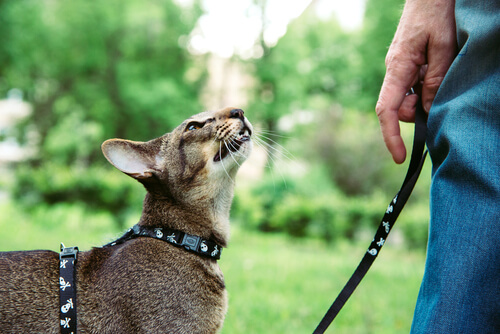There are certain breeds of cats that think like dogs, carrying out behavioral patterns among which the desire to bond with humans stands out. This sociability manifests itself through body language itself and can be enhanced through various workouts.
There is a deep-rooted belief in regard to the independent and distant attitude of cats, usually conceived as the opposition of dogs. However, not all domestic felines identify with such stereotypes, as they love the game, respond to their name and even enjoy the water.
Some of the common gestures between dogs and cats that think like dogs are the multiple facial expressions, including the movement of the ears. The activity of the tail and even the degree of arching of the back are also important indicators of the level of well-being of these animals.
Further, both species are characterized by the great development of their olfactory and auditory system, important in the recognition and communication with other animals.
Cat breeds that think like dogs
Although any cat can behave like a dog, both for genetic reasons and for the influence of the environment, there are a number of more prone breeds:
- The abyssinian. Ethologists define it as the ideal cat for those who are accustomed to dealing with dogs. It is energetic, sociable, responds to the search for toys, follows its owner and normally he likes water. Likewise, he is receptive to belt training.
- Ragdoll. The name of this species is translated as ‘rag doll’ given the meek and sociable character of the animal. Although it is playful, its distinctive feature is the placidity with which he responds to the caresses of his owner and others to home. In addition, it is the ideal feline for living with other animals.
- Turkish Angora. It is one of the cats most similar to dogs, given its desire to be the center of attention. He is playful, faithful and sociable, and usually stands out for his receptivity with visits outside the home. To all this is added its good swimming ability.
- The Maine Coon. It is one of the largest domestic cat breeds and overcome many small breed dogs. It shows Devout and playful with its owner, and is able to bring the toys back. When it comes to visits, you may be more suspicious.
How to enhance canine behavior
In addition to the existence of certain breeds of cats that think like dogs, some measures can be taken to increase such sociability.
- Perform agility training and memory. Although it may involve more dedication than with dogs, cats can attend to their name, look for toys and even bring them. The results are usually more successful when working with whistles, so that behaviors are associated with sounds.
- Take walks. Some cats, given their meek character, usually respond positively to leashes. These guided outings they must be done in quiet places, which will guarantee the absence of dogs.

- Development with dogs. When cats grow alongside dogs, as long as the latter are receptive and calm, usually mimic canine behavior patterns. Similarly, enhancing human contact in the first months of life will increase the sociability of the feline.
However, it is important to conceive the limits of each species, so that training in regards to urine and feces, or in the accumulation of the number of orders, should not be equated.
Finding out about feline breeds that are more in line with one’s own lifestyle is essential to achieve well-being. common. It is also important to be aware that a good part of a pet’s character will be a reflection of what they have learned from their daily surrounding.
Traditionally, it has been said that felines are independent, but there are studies that claim that cats can have different personalities. Read more “
